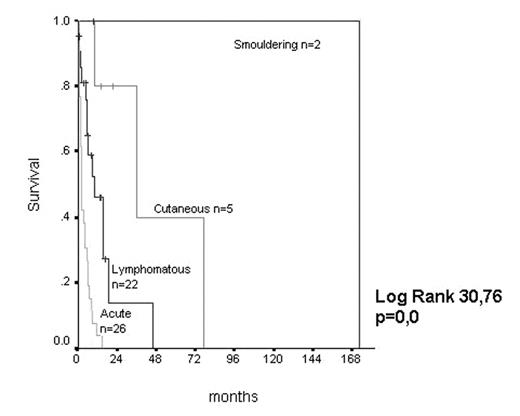Abstract
Adult T -cell leukaemia/lymphoma (ATL) is an aggressive disease associated with human T-cell lymphotropic virus type-I (HTLV-I) with heterogeneous clinical presentation and outcomes, described in Southern Japan, Europe, Caribbean and previously on Pacific coast of South America including Peru (EHA 2001, abst. 304). Shimoyama’s ATL classification (
Treatment for acute ATL was based on acute leukaemia and lymphoma regimens without any response but one, interestingly this patient was treated with Fludarabine 25 mg/mt2 day 1–5 each 28 day for 6 cycles and got complete remission. Twenty-one over 24 lymphomatous ATL type were evaluable for treatment response: overall response 38% (9/24) with 26% complete response. Smouldering and cutaneous ATL types received mainly topic treatments. Stratify analysis for IPI, DHL, beta-2 microglobulin, globulin and albumin for acute and non-acute ATL did not show any statistic difference. Median overall survival was: acute type (2.0 months DE 0.2), lymphomatous type (10.2 months DE 3.6), smouldering type (17.2 months) and cutaneous type (36.2 months DE 19.5) (Log Rank 30,76 p=0.0)
ATL persist is a poor prognostic peripheral T-lymphocytic malignancy with bad clinical and therapeutically outcomes mainly in the acute type. Cutaneous type seems to be less aggressive.
Author notes
Corresponding author


